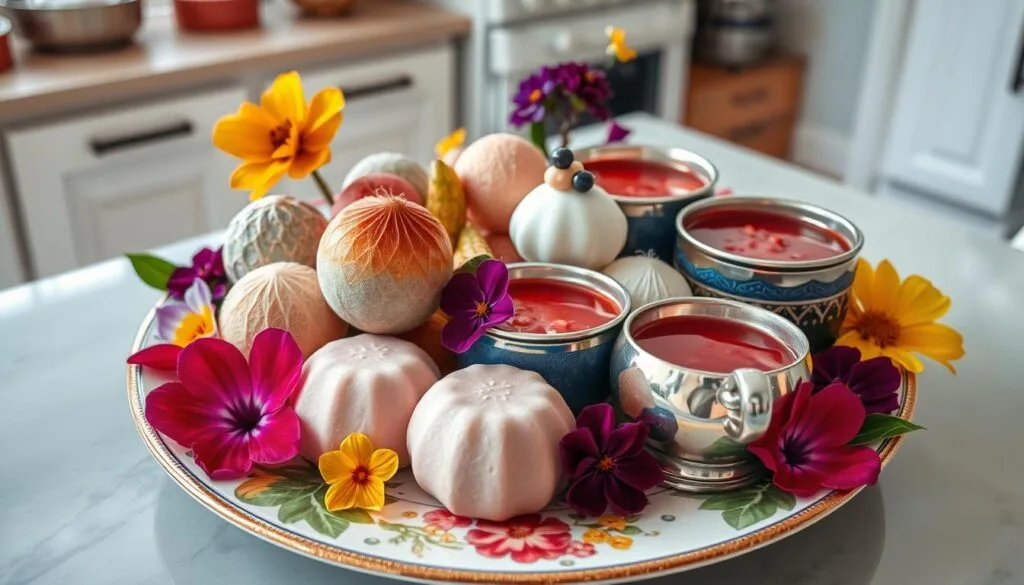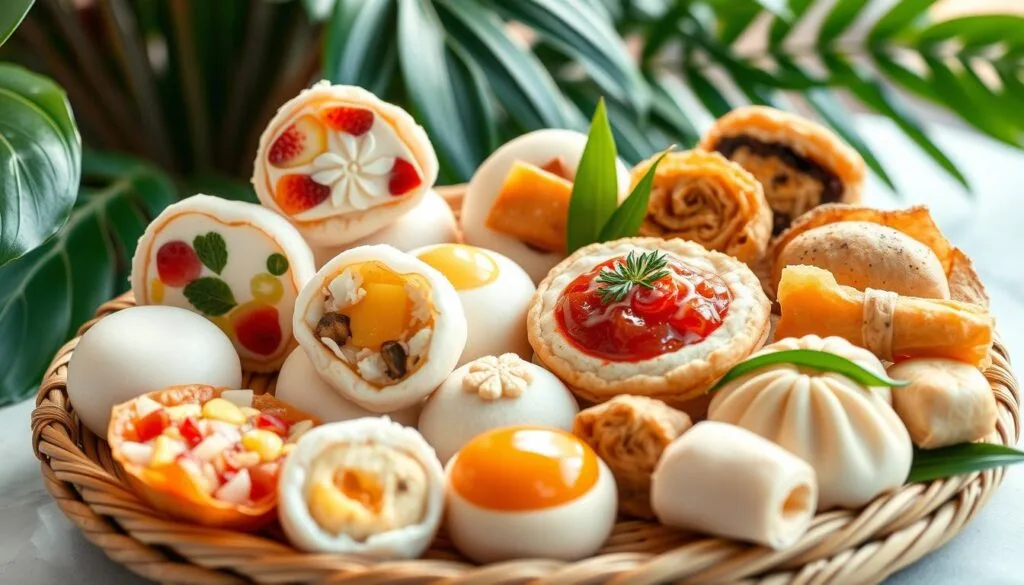Ultimate Sweet Asian Desserts: Traditional Treats & Recipes
As you walk through lively night markets, you’re greeted by amazing smells. Sweet Asian desserts call out to you from everywhere. Each bite is more than just tasty; it’s a story of heritage and memories.
Imagine biting into a mooncake during the Mid-Autumn Festival. Or savoring mango sticky rice’s creamy sweetness. These treats take you on a journey through flavors and history.
Exploring these desserts, you’ll find recipes passed down through generations. Each dish is a mix of adventure and a link to the past. It’s a chance to connect with traditions and cultures.
Table of Contents
Introduction to Asian Desserts
Asian desserts are known for their stunning looks and perfect mix of tastes. These classic asian desserts use special ingredients that share stories from old traditions. They are loved by many around the world because of their deep history.
In the 1970s, Asian and Western cooking styles merged, creating a new kind of asian-inspired sweets. Chefs mixed flavors like matcha, black sesame, and red bean paste with new cooking methods. This made for exciting desserts. Now, thanks to Instagram and TikTok, these treats are enjoyed by people everywhere.
Some popular asian desserts to try are Mochi Ice Cream and Bubble Tea Pancakes. These desserts use tropical fruits like mangoes and traditional ingredients like glutinous rice and sweet red bean paste.
Asian fusion desserts offer a fresh taste experience while keeping their cultural roots. You can even make these desserts at home. Try making Matcha Cheesecake or Mango Sticky Rice Spring Rolls for a taste of Asia.
The Rich History of Traditional Asian Sweets
Traditional sweets in Asia show the rich cultures and histories of the past. Each area has its own special desserts made from local ingredients and old methods. These traditions have been passed down for generations.
In China, making desserts is an art form. It includes the Four Great Traditions and the New Eight Great Traditions. Mooncakes are a big part of the Mid-Autumn Festival. They symbolize unity and harmony, bringing families together.
Japan’s desserts, like wagashi, are made for tea ceremonies. They show the art of food making. Ingredients like red bean paste and sweet potatoes add depth to desserts like taiyaki and dango.
Traditional sweets are made in many ways, like steaming and frying. Some desserts are even made with sweet soups or curdling milk with ginger juice. This variety shows the skill and history behind each dessert.
Exploring these desserts, you’ll find stories in every bite. They connect us to a rich cultural past. Each flavor tells a part of history.
Popular Asian Desserts You Must Try
Asian desserts are a journey of unique flavors and textures. They use ingredients that excite your taste buds. Mango Sticky Rice is a standout with its sweet taste. It’s a classic Thai dish made with glutinous rice, ripe mango, and creamy coconut sauce.
Preparation takes about 50 minutes, making it a rewarding treat to enjoy.
Halo-Halo from the Philippines is another must-try. It’s a colorful mix of sweetened beans, gelatin, coconut, and fresh fruits like mango and jackfruit. It’s perfect for hot days. Its vibrant look makes it a favorite among popular Asian sweets.
The Japanese Dorayaki is also worth trying. It has fluffy pancakes filled with sweet red bean paste. These treats are ready in about 30 minutes, perfect for a quick sweet fix. Each bite captures the essence of Japanese tradition.
Trying these desserts opens a world of tastes and textures from different cultures. Their unique ingredients and preparation methods make them favorites in Asia and worldwide.
Classic Asian Pastries and Their Unique Flavors
Asian pastries mix cultural traditions with new flavors. Each area has its own special pastries that excite your taste buds. These desserts have flaky textures, rich fillings, and layers of taste that go beyond sweetness.
The Chinese egg tart is a favorite. It has a flaky crust and a smooth egg custard inside. This mix of crispy and creamy is a masterpiece of Asian pastry art.
In Korea, hotteok offers a savory twist. These pancakes are filled with sweet syrup, nuts, and cinnamon. They’re a warm, comforting snack for cold days, sold by street vendors.
The Japanese taiyaki stands out with its fish shape. Traditionally, it’s filled with sweet red bean paste. But you can also find it with custard or chocolate, pleasing many tastes.
Tasting these classic Asian pastries lets you enjoy their varied flavors and textures. They often bring back memories or connect us to our culture. Enjoying them can make any moment special, thanks to shared food traditions.
Exploring Delicious Asian Treats for Every Occasion
Asian desserts are full of flavors and textures, great for any celebration. You’ll find tropical treats and textured sweets that make any event special. Discover mango sticky rice, halo-halo, and mochi treats, each with its own cultural story and delicious taste.
Mango Sticky Rice: A Thai Classic
Mango sticky rice is a sweet and creamy Thai dessert. It combines fresh mangoes with soft rice, all in a coconut sauce. Enjoyed in summer or at festivals, it’s a refreshing treat that celebrates Thai cuisine.
Filipino Halo-Halo: A Refreshing Treat
Halo-halo is a colorful Filipino dessert served over shaved ice. It has sweet fruits, jellies, and beans, topped with creamy leche flan or ube ice cream. It’s perfect for summer, offering a fun experience for all.
Japanese Mochi: The Versatile Delight
Mochi treats are made from glutinous rice, creating chewy bites. They can be filled with sweet or savory ingredients, making them versatile. Enjoy them on their own or in desserts like daifuku, adding excitement to any table.
Simple Asian Dessert Recipes You Can Make at Home
Exploring homemade Asian desserts is a fun journey. Easy recipes let you bring tradition into your kitchen. Here are three simple yet tasty desserts you can make at home.
Homemade Black Sesame Ice Cream
This ice cream has a rich, nutty taste that will wow everyone. Mix black sesame seeds with sugar, milk, and cream. Then, churn it in an ice cream maker for a smooth treat perfect for hot days.
Jiggly Japanese Cheesecake Recipe
This cheesecake is light and fluffy, a true delight. Mix cream cheese, sugar, eggs, and whipped cream. Bake it in a water bath for that special jiggle. It’s beautiful and delicious, great for any gathering.
Vietnamese Tapioca Pudding: Che Chuoi Chung

This pudding is a comfort food dream. It has tapioca pearls, ripe bananas, coconut milk, and sweet syrup. The mix of chewy tapioca and soft banana is amazing. It’s a perfect dessert for any time.
With these desserts, you can dive into the world of Asian sweets. Impress your loved ones with your cooking skills. Each recipe brings a unique taste of tradition to your table.
Asian Desserts With Unique Ingredients
Exploring unique Asian desserts shows a world of vibrant flavors and colors. These come from exotic ingredients with deep cultural meanings. Pandan, for example, adds a fragrant aroma and a green color to desserts. It’s a key ingredient in Southeast Asian sweets, making cakes and puddings taste better.
Red bean is another standout. It’s sweet and creamy, found in red bean paste or mochi. It’s loved in treats like dorayaki and as fillings for buns and pancakes.
Ube, or purple yam, is becoming more popular. Its natural sweetness is perfect for ube cake or ube ice cream. Its striking color and taste make desserts exciting.
Using exotic dessert ingredients brings creativity to your cooking. Try adding coconut or matcha to your desserts. From mango sticky rice to matcha white chocolate cookies, unique ingredients make your kitchen adventures unforgettable.
Sweet and Savory Asian Pastries to Satisfy Your Cravings
Asian pastries are a mix of sweet and savory, pleasing many tastes. Korean hotteok and Hokkaido baked cheese tarts are favorites. They show Asia’s rich food culture and satisfy both sweet and savory cravings.
Korean Hotteok: Sweet Syrup Pancakes
Korean hotteok is a warm treat for cold days. It’s filled with brown sugar, cinnamon, and nuts, making a sweet syrup. The crispy outside and soft inside make it hard to resist.
Hotteok is a popular street food snack. It takes you to markets with amazing smells and tastes.
Hokkaido Baked Cheese Tarts: A Creamy Delight
Hokkaido baked cheese tarts are creamy and rich. They come from Japan’s Hokkaido island. The flaky crust holds a cheese filling with a hint of sweetness.
The cheese and sugar mix is irresistible. Enjoy them warm or cold. Hokkaido cheese tarts are a perfect mix of sweet and savory.

Celebrating Festivals with Asian Dessert Traditions
Festivals in Asia are filled with delicious desserts that show off cultural heritage and unity. These treats are not just tasty but also bring people together. Mooncakes and taho are two desserts that highlight the spirit of these celebrations.
Mooncakes: The Star of the Mid-Autumn Festival
Mooncakes are a big deal during the Mid-Autumn Festival, celebrated for over 2,000 years. Families come together to enjoy these round pastries filled with red bean, lotus seed, and more. They symbolize completeness and reunion, making them key to the festivities.
In Asia, mooncakes are celebrated differently in each country. The Vietnamese Moon Fest, for example, focuses on family with treats like the Five-Fruit Tray. In Malaysia, Singapore, and Thailand, mooncakes honor their Chinese heritage, keeping these sweets alive across cultures.
Taho: A Favorite Filipino Dessert for Celebrations
Taho is a favorite in the Philippines, enjoyed at festivals and everyday. It’s made from silken tofu, sweet syrup, and sago pearls. Taho vendors are a common sight, calling out to passersby.
This dessert is more than just tasty; it’s a symbol of community. At festivals, taho brings families together, fostering bonding and laughter. It shows how desserts enrich culture and strengthen social ties.
Conclusion
In this journey through Asian desserts, you’ve seen a world of flavors and traditions. From mochi’s chewiness to halo-halo’s coolness, these sweets show Asia’s rich history and modern tastes. They use special ingredients like coconut milk and tropical fruits, blending sweetness and richness.
Exploring these recipes, you’ll find vegan and gluten-free options for today’s diets. These choices mean everyone can enjoy Asian desserts, even with dietary limits. Favorites like zongzi and black sticky rice pudding bring families together, creating special moments.
Trying recipes like Cocoa Brownies with miso or matcha lava cake invites you into Asia’s sweet world. Adding these desserts to your life not only grows your dessert collection but also respects their cultural value. Let their flavors and textures bring you joy, making every moment special.







